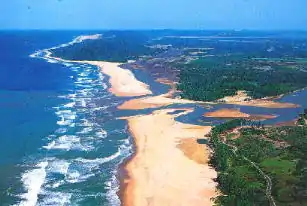Mycoplankton
Mycoplankton are saprotropic members of the plankton communities of marine and freshwater ecosystems.[1][2] They are composed of filamentous free-living fungi and yeasts that are associated with planktonic particles or phytoplankton.[3] Similar to bacterioplankton, these aquatic fungi play a significant role in heterotrophic mineralization and nutrient cycling.[4] Mycoplankton can be up to 20 mm in diameter and over 50 mm in length.[5]
| Part of a series on |
| Plankton |
|---|
 |
In a typical milliliter of seawater, there are approximately 103 to 104 fungal cells.[6] This number is greater in coastal ecosystems and estuaries due to nutritional runoff from terrestrial communities. The greatest diversity and number of species of mycoplankton is found in surface waters (< 1000 m), and the vertical profile depends on the abundance of phytoplankton.[7][8] Furthermore, this difference in distribution may vary between seasons due to nutrient availability.[9] Aquatic fungi survive in a constant oxygen deficient environment, and therefore depend on oxygen diffusion by turbulence and oxygen generated by photosynthetic organisms.[10]
Aquatic fungi can be classified using three groups:[10]
- Lower fungi - adapted to marine habitats (zoosporic fungi, including mastigomycetes: oomycetes & chytridiomycetes)
- Higher fungi -filamentous, modified to planktonic lifestyle (hyphomycetes, ascomycetes, basidiomycetes)
- Terrestrial fungi - contain appendages of marine fungi (trichomycetes)
The majority of mycoplankton species are higher fungi, found in the Ascomycota and Basidiomycota phyla.[7]
According to fossil records, fungi date back to the late Proterozoic era, 900-570 million years ago. It is hypothesized that mycoplankton evolved from terrestrial fungi, likely in the Paleozoic era (390 million years ago).[11] The methods and pathways of terrestrial fungi's adaption to the marine environment are still under study.
Biogeochemical Contributions
The primary role of all fungi is to degrade detrital organic matter from plants,[12][13] and mycoplankton is no exception. By working with microbial communities, mycoplankton efficiently converts particulate organic matter to dissolved organic matter as part of the biogeochemical cycle.[14] Mycoplankton and heterotrophic bacteria mediate carbon, nitrogen, oxygen, and other nutrient fluxes in marine ecosystems.[15] It has been shown that there are higher concentrations of mycoplankton near the surface and in shallow waters, which indicates their connection with the upwelling of organic matter. This further correlates with abundant phytoplankton communities at the surface, implying that mycoplankton is intimately involved in organic matter consumption in the euphotic zone.[3][9]
See also
- Algae – Diverse group of photosynthetic eukaryotic organisms
- Bacterioplankton – bacterial component of the plankton that drifts in the water column
- Biological pump – The ocean's biologically driven sequestration of carbon from the atmosphere to the ocean interior and seafloor
- Fungus – Kingdom of eukaryotes that includes mushrooms, yeasts, molds and related organisms
- Marine fungi
- Phytoplankton – Autotrophic members of the plankton ecosystem
- Zooplankton – Heterotrophic protistan or metazoan members of the plankton ecosystem
References
- Jones, E.B.G., Hyde, K.D., & Pang, K.-L., eds. (2014). Freshwater fungi: and fungal-like organisms. Berlin/Boston: De Gruyter.
- Jones, E.B.G.; Pang, K.-L., eds. (2012). Marine Fungi, and Fungal-like Organisms. Marine and Freshwater Botany. Berlin, Boston: De Gruyter (published August 2012). ISBN 978-3-11-026406-7. Retrieved September 3, 2015.
- Wang, X; Singh, P; Gao, Z; Zhang, X; Johnson, ZI; Wang, G (2014). "Distribution and Diversity of Planktonic Fungi in the West Pacific Warm Pool". PLOS ONE. 9 (7): e101523. Bibcode:2014PLoSO...9j1523W. doi:10.1371/journal.pone.0101523.s001. PMC 4081592. PMID 24992154.
- Wang, G.; Wang, X.; Liu, X.; Li, Q. (2012). "Diversity and biogeochemical function of planktonic fungi in the ocean". In Raghukumar, C. (ed.). Biology of marine fungi. Berlin, Heidelberg: Springer-Verlag. pp. 71–88. doi:10.1007/978-3-642-23342-5. ISBN 978-3-642-23341-8. Retrieved September 3, 2015.
- Damare, Samir; Raghukumar, Chandralata (2007-11-11). "Fungi and Macroaggregation in Deep-Sea Sediments". Microbial Ecology. 56 (1): 168–177. doi:10.1007/s00248-007-9334-y. ISSN 0095-3628. PMID 17994287.
- Kubanek, Julia; Jensen, Paul R.; Keifer, Paul A.; Sullards, M. Cameron; Collins, Dwight O.; Fenical, William (2003-06-10). "Seaweed resistance to microbial attack: A targeted chemical defense against marine fungi". Proceedings of the National Academy of Sciences. 100 (12): 6916–6921. Bibcode:2003PNAS..100.6916K. doi:10.1073/pnas.1131855100. ISSN 0027-8424. PMC 165804. PMID 12756301.
- Gao, Zheng; Johnson, Zackary I.; Wang, Guangyi (2009-07-30). "Molecular characterization of the spatial diversity and novel lineages of mycoplankton in Hawaiian coastal waters". The ISME Journal. 4 (1): 111–120. doi:10.1038/ismej.2009.87. ISSN 1751-7362. PMID 19641535.
- Panzer, Katrin; Yilmaz, Pelin; Weiß, Michael; Reich, Lothar; Richter, Michael; Wiese, Jutta; Schmaljohann, Rolf; Labes, Antje; Imhoff, Johannes F. (2015-07-30). "Identification of Habitat-Specific Biomes of Aquatic Fungal Communities Using a Comprehensive Nearly Full-Length 18S rRNA Dataset Enriched with Contextual Data". PLOS ONE. 10 (7): e0134377. Bibcode:2015PLoSO..1034377P. doi:10.1371/journal.pone.0134377. PMC 4520555. PMID 26226014.
- GUTIERREZ, Marcelo H; PANTOJA, Silvio; QUINONES, Renato A and GONZALEZ, Rodrigo R. First record of flamentous fungi in the coastal upwelling ecosystem off central Chile. Gayana (Concepc.) [online]. 2010, vol.74, n.1, pp. 66-73. ISSN 0717-6538.
- Sridhar, K.R. (2009). "10. Aquatic fungi – Are they planktonic?". Plankton Dynamics of Indian Waters. Jaipur, India: Pratiksha Publications. pp. 133–148.
- Jones, E. B. Gareth; Pang, Ka-Lai (2012-08-31). Marine Fungi: and Fungal-like Organisms. Walter de Gruyter. ISBN 9783110264067.
- Carlile MJ, Watkinson SC, Gooday GW (2001) The fungi. San Diego: Academic Press.
- Pang, Ka-Lai; Mitchell, Julian I. (2005). "Molecular approaches for assessing fungal diversity in marine substrata". Botanica Marina. 48 (5–6). doi:10.1515/bot.2005.046.
- Kiørboe, Thomas; Jackson, George A. (2001-09-01). "Marine snow, organic solute plumes, and optimal chemosensory behavior of bacteria". Limnology and Oceanography. 46 (6): 1309–1318. Bibcode:2001LimOc..46.1309K. CiteSeerX 10.1.1.570.5719. doi:10.4319/lo.2001.46.6.1309. ISSN 1939-5590.
- Buesing, Nanna; Gessner, Mark O. (2006-01-01). "Benthic Bacterial and Fungal Productivity and Carbon Turnover in a Freshwater Marsh". Applied and Environmental Microbiology. 72 (1): 596–605. doi:10.1128/AEM.72.1.596-605.2006. ISSN 0099-2240. PMC 1352256. PMID 16391096.


